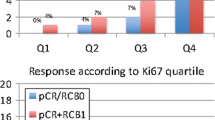Abstract
Background
Indication for chemotherapy in estrogen receptor (ER)-positive and human epidermal growth factor receptor 2 (HER2)-negative breast cancers is determined on the basis of Ki67 expression level. However, since Ki67-high cancers are not necessarily sensitive to chemotherapy, identification of such patients who do not need chemotherapy is an important issue.
Patients and methods
We used immunohistochemical staining to examine the expression levels of ER, progesterone receptor (PgR), Ki67, and geminin, a marker of S to G2/M phases, in 80 ER-positive/HER2-negative breast cancers. The labeling indices of Ki67 and geminin were determined and cutoff values were set at 15 and 6 %, respectively.
Results
Ki67 and geminin expression levels were significantly associated with nuclear grade. In the Ki67-low subset, 26 out of 28 (92.9 %) cancers were geminin low and in the Ki67-high subset, 31 out of 52 (59.6 %) were geminin high. Distant disease-free survival (DDFS) of the geminin-high subset was significantly poorer than that of the geminin-low subset (P = 0.009). In the Ki67-low subset, only one patient showed recurrence. Metastasis was detected in eight out of 31 (25.8 %) patients in the geminin-high group of the Ki67-high subset, but no recurrence was observed in the geminin-low group of the Ki67-high subset.
Conclusion
Geminin-high breast cancers are significantly associated with worse prognosis. Since poorer prognosis was recognized only in the geminin-high group in Ki67-high cancers, we speculate that geminin may be useful for identifying patients in the Ki67-high subset who can avoid unnecessary chemotherapy.





Similar content being viewed by others
References
Goldhirsch A, Winer EP, Coates AS, Gelber RD, Piccart-Gebhart M, Thürlimann B, et al. Personalizing the treatment of women with early breast cancer: highlights of the St Gallen International Expert Consensus on the Primary Therapy of Early Breast Cancer 2013. Ann Oncol. 2013;24:2206–23.
García-Estevez L, Contreras AC, Calvo I, Abad MF, de la Cruz JJ, Perea S, et al. Can Oncotype DX recurrence score (RS) be used in luminal A and luminal B breast cancer patients (pts) to predict the likely benefit of chemotherapy- A retrospective study in the Spanish population. J Clin Oncol 2012;30 (suppl; abstr e11006).
Abdel-Fatah TM, Powe DG, Ball G, Lopez-Garcia MA, Habashy HO, Green AR, et al. Proposal for a modified grading system based on mitotic index and Bcl2 provides objective determination of clinical outcome for patients with breast cancer. J Pathol. 2010;222:388–99.
Wirapati P, Sotiriou C, Kunkel S, Farmer P, Pradervand S, Haibe-Kains B, et al. Meta-analysis of gene expression profiles in breast cancer: toward a unified understanding of breast cancer subtyping and prognosis signatures. Breast Cancer Res. 2008;10:R65.
Teschendorff AE, Naderi A, Barbosa-Morais NL, Pinder SE, Ellis IO, Aparicio S, et al. A consensus prognostic gene expression classifier for ER positive breast cancer. Genome Biol. 2006;7:R101.
Stanton KJ, Sidner RA, Miller GA, Cummings OW, Schmidt CM, Howard TJ, et al. Analysis of Ki-67 antigen expression, DNA proliferative fraction, and survival in resected cancer of the pancreas. Am J Surg. 2003;186:486–92.
Gonzalez MA, Tachibana KE, Chin SF, Callagy G, Madine MA, Vowler SL, et al. Geminin predicts adverse clinical outcome in breast cancer by reflecting cell-cycle progression. J Pathol. 2004;204:121–30.
Winking H, Gerdes J, Traut W. Expression of the proliferation marker Ki-67 during early mouse development. Cytogenet Genome Res. 2004;105:251–6.
Kulkarni AA, Loddo M, Leo E, Rashid M, Eward KL, Fanshawe TR, et al. DNA replication licensing factors and aurora kinases are linked to aneuploidy and clinical outcome in epithelial ovarian carcinoma. Clin Cancer Res. 2007;13:6153–61.
Loddo M, Kingsbury SR, Rashid M, Proctor I, Holt C, Young J, et al. Cell-cycle-phase progression analysis identifies unique phenotypes of major prognostic and predictive significance in breast cancer. Br J Cancer. 2009;100:959–70.
Sakamoto G, Inaji H, Akiyama F, Haga S, Hiraoka M, Inai K, et al. Japanese Breast Cancer Society. General rules for clinical and pathological recording of breast cancer 2005. Breast Cancer. 2005;12(Suppl):S1–27.
Cheang MC, Chia SK, Voduc D, Gao D, Leung S, Snider J, et al. Ki67 index, HER2 status, and prognosis of patients with luminal B breast cancer. J Natl Cancer Inst. 2009;101:736–50.
Di Bonito M, Cantile M, Collina F, Scognamiglio G, Cerrone M, La Mantia E, et al. Overexpression of cell cycle progression inhibitor geminin is associated with tumor stem-like phenotype of triple-negative breast cancer. Breast Cancer. 2012;15:162–71.
Ali HR, Dawson SJ, Blows FM, Provenzano E, Pharoah PD, Caldas C. Aurora kinase A outperforms Ki67 as a prognostic marker in ER-positive breast cancer. Br J Cancer. 2012;106:1798–806.
Gardner L, Malik R, Shimizu Y, Mullins N, Elshamy WM. Geminin overexpression prevents the completion of topoisomerase IIα chromosome decatenation, leading to aneuploidy in human mammary epithelial cells. Breast Cancer Res. 2011;13:R53.
Sundara RS, Hanby AM, Horgan K, Thygesen HH, Speirs V. The potential utility of geminin as a predictive biomarker in breast cancer. Breast Cancer Res Treat. 2014;143:91–8.
Conflict of interest
Y. Miyoshi has received honoraria from Chugai Pharmaceutical Co., Ltd., AstraZeneca K.K., GlaxoSmithKline K.K., and research funding from Taiho Pharmaceutical Co., Ltd., Chugai Pharmaceutical Co., Ltd. The other authors declare that they have no conflict of interest.
Author information
Authors and Affiliations
Corresponding author
About this article
Cite this article
Yagi, T., Inoue, N., Yanai, A. et al. Prognostic significance of geminin expression levels in Ki67-high subset of estrogen receptor-positive and HER2-negative breast cancers. Breast Cancer 23, 224–230 (2016). https://doi.org/10.1007/s12282-014-0556-9
Received:
Accepted:
Published:
Issue Date:
DOI: https://doi.org/10.1007/s12282-014-0556-9




